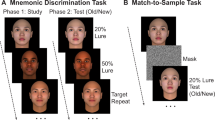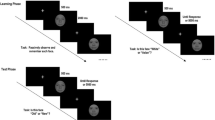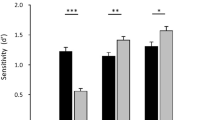Abstract
Many studies have shown that people remember faces of their own race better than faces of other races. We investigated the neural substrates of same-race memory superiority using functional MRI (fMRI). European-American (EA) and African-American (AA) males underwent fMRI while they viewed photographs of AA males, EA males and objects under intentional encoding conditions. Recognition memory was superior for same-race versus other-race faces. Individually defined areas in the fusiform region that responded preferentially to faces had greater response to same-race versus other-race faces. Across both groups, memory differences between same-race and other-race faces correlated with activation in left fusiform cortex and right parahippocampal and hippocampal areas. These results suggest that differential activation in fusiform regions contributes to same-race memory superiority.
This is a preview of subscription content, access via your institution
Access options
Subscribe to this journal
Receive 12 print issues and online access
$209.00 per year
only $17.42 per issue
Buy this article
- Purchase on Springer Link
- Instant access to full article PDF
Prices may be subject to local taxes which are calculated during checkout



Similar content being viewed by others
References
Malpass, R. S. & Kravitz, J. Recognition for faces of own and other race. J. Pers. Soc. Psychol. 13, 330–334 (1969).
Brigham, J. & Barkowitz, P. Do “they all look alike?” The effect of race, sex, experience and attitudes on the ability to recognize faces. J. Appl. Soc. Psychol. 8, 306–318 (1978).
Brigham, J. & Malpass, R. The role of experience and contact in the recognition of own- and other-race persons. J. Soc. Issues 41, 139–155 (1985).
Carroo, A. Other race face recognition: a comparison of Black American and African subjects. Percept. Mot. Skills 62, 135–138 (1986).
Fallshore, M. & Schooler, J. W. Verbal vulnerability of perceptual expertise. J. Exp. Psychol. Learn. Mem. Cogn. 21, 1608–1623 (1995).
Diamond, R. & Carey, S. Why faces are and are not special: an effect of expertise. J. Exp. Psychol. Gen. 115, 107–117 (1986).
Yarmey, A. Recognition memory for familiar “public” faces: effects of orientation and delay. Psychon. Sci. 24, 286–288 (1971).
Yin, R. Looking at upside down faces. J. Exp. Psychol. 81, 141–145 (1969).
Rhodes, G., Tan, S., Brake, S. & Taylor, K. Expertise and configural coding in face recognition. Br. J. Psychol. 80, 313–331 (1989).
Levin, D. Race as a visual feature: using visual search and perceptual discrimination tasks to understand face categories and the cross-race recognition deficit. J. Exp. Psych. Gen. 129, 559–574 (2000).
Chance, J. & Goldstein, A. in Psychological Issues in Eyewitness Identification (eds. Sporer, S., Malpass, R. & Koehnken, G.) 153–176 (Erlbaum, Mahwah, New Jersey, 1996).
De Renzi, E. & Spinnler, H. Facial recognition in brain-damaged patients. An experimental approach. Neurology 16, 145–152 (1966).
Ellinwood, E. H. Jr. Perception of faces: disorders in organic and psychopathological states. Psychiatr. Q. 43, 622–646 (1969).
Benton, A. L. & Van Allen, M. W. Impairment in facial recognition in patients with cerebral disease. Trans. Am. Neurol. Assoc. 93, 38–42 (1968).
Haxby, J. V. et al. The functional organization of human extrastriate cortex: a PET-rCBF study of selective attention to faces and locations. J. Neurosci. 14, 6336–6353 (1994).
Sergent, J., Ohta, S. & MacDonald, B. Functional neuroanatomy of face and object processing: a positron emission tomography study. Brain 115 Pt. 1, 15–36 (1992).
Kanwisher, N., McDermott, J. & Chun, M. M. The fusiform face area: a module in human extrastriate cortex specialized for face perception. J. Neurosci. 17, 4302–4311 (1997).
Puce, A., Allison, T., Gore, J. C. & McCarthy, G. Face-sensitive regions in human extrastriate cortex studied by functional MRI. J. Neurophysiol. 74, 1192–1199 (1995).
Gauthier, I., Skudlarski, P., Gore, J. C. & Anderson, A. W. Expertise for cars and birds recruits brain areas involved in face recognition. Nat. Neurosci. 3, 191–197 (2000).
Gauthier, I., Tarr, M. J., Anderson, A. W., Skudlarski, P. & Gore, J. C. Activation of the middle fusiform 'face area' increases with expertise in recognizing novel objects. Nat. Neurosci. 2, 568–573 (1999).
Anthony, T., Copper, C. & Mullen, B. Cross-racial facial identification: a social cognitive integration. Pers. Soc. Psych. Bull. 18, 296–301 (1992).
Puce, A., Allison, T., Asgari, M., Gore, J. & McCarthy, G. Face-sensitive regions in extrastriate cortex studied by functional MRI. Neurophysiology 74, 1192–1199 (1996).
Kosslyn, S. et al. Evidence for two types of spatial representations: hemispheric specialization for categorical and coordinate relations. J. Exp. Psychol. Hum. Percept. Perform. 15, 723–735 (1989).
Warrington, E. & James, M. An experimental investigation of facial recognition in patients with unilateral cerebral lesions. Cortex 3, 317–326 (1967).
Milner, B. Visual recognition and recall after right temporal-lobe excision in man. Neuropsychologia 6, 191–209 (1968).
Heit, G., Smith, M. E. & Halgren, E. Neural encoding of individual words and faces by the human hippocampus and amygdala. Nature 333, 773–775 (1988).
Seeck, M. et al. Differential neural activity in the human temporal lobe evoked by faces of family members and friends. Ann. Neurol. 34, 369–372 (1993).
Haxby, J. V. et al. Face encoding and recognition in the human brain. Proc. Natl. Acad. Sci. USA 93, 922–997 (1996).
Kapur, N., Friston, K. J., Young, A., Frith, C. D. & Frackowiak, R. S. Activation of human hippocampal formation during memory for faces: a PET study. Cortex 31, 99–108 (1995).
Kelley, W. et al. Hemispheric specialization in human dorsal frontal cortex and medial temporal lobe for verbal and nonverbal encoding. Neuron 20, 927–936 (1998).
Bruyer, R. & Crispeels, G. Expertise in person recognition. Bull. Psychon. Soc. 30, 501–504 (1992).
Gross, C. G., Bender, D. B. & Rocha-Miranda, C. E. Visual receptive fields of neurons in inferotemporal cortex of the monkey. Science 166, 1303–1306 (1969).
Rolls, E. T. Neurophysiological mechanisms underlying face processing within and beyond the temporal cortical visual areas. Philos. Trans. R. Soc. Lond. Biol. 335, 11–20 (1992).
Logothetis, N. K. Object recognition: holistic representations in the monkey brain. Spat. Vis. 13, 165–178 (2000).
Chance, J. E., Turner, A. L. & Goldstein, A. G. Development of differential recognition for own- and other-race faces. J. Psychol. 112, 29–37 (1982).
Kuskowski, M. A. & Pardo, J. V. The role of the fusiform gyrus in successful encoding of face stimuli. Neuroimage 9, 599–610 (1999).
Katanoda, K., Yoshikawa, K. & Sugishita, M. Neural substrates for the recognition of newly learned faces: a functional MRI study. Neuropsychologia 38, 1616–1625 (2000).
Wojciulik, E., Kanwisher, N. & Driver, J. Covert visual attention modulates face-specific activity in the human fusiform gyrus: fMRI study. J. Neurophysiol. 79, 1574–1578 (1998).
O'Craven, K. M., Downing, P. E. & Kanwisher, N. fMRI evidence for objects as the units of attentional selection. Nature 401, 584–587 (1999).
Kanwisher, N. Domain specificity in face perception. Nat. Neurosci. 3, 759–763 (2000).
Phelps, E. A. et al. Performance on indirect measures of race evaluation predicts amygdala activation. J. Cogn. Neurosci. 12, 729–738 (2000).
Hart, A. J. et al. Differential response in the human amygdala to racial outgroup vs ingroup face stimuli. Neuroreport 11, 2351–2355 (2000).
Phelps, E. A. & Anderson, A. K. Emotional memory: what does the amygdala do? Curr. Biol. 7, R311–R314 (1997).
Cahill, L. et al. Amygdala activity at encoding correlated with long-term, free recall of emotional information. Proc. Natl. Acad. Sci. USA 93, 8016–8021 (1996).
Canli, T., Zhao, Z., Brewer, J., Gabrieli, J. D. & Cahill, L. Event-related activation in the human amygdala associates with later memory for individual emotional experience. J. Neurosci. 20, RC99 (2000).
Phinney, J. The multigroup ethnic identity measure. J. Adolosc. Res. 7, 156–176 (1992).
Macwhinney, B., Cohen, J. & Provost, J. The PsyScope experiment-building system. Spat. Vis. 11, 99–101 (1997).
Glover, G. H. & Lai, S. Self-navigated spiral fMRI: Interleaved versus single-shot. Magn. Reson. Med. 39, 361–368 (1998).
Talairach, J. & Tournoux, P. Co-planar Atlas of the Human Brain (Thieme, New York, 1988).
Acknowledgements
We thank J. Henderson for permission to use the antique radio pictures, T. Canli for help with data collection and analysis during the early phase of this research, and N. Dudukovic for assistance with data analysis. This research was supported by NIH F32 NS10925-01 grant to A.J.G., Stanford University Office of Technology and Licensing (OTL) grant 2EQA101 to J.L.E., NSF BCS9986128 grant to J.L.E. and J.D.E.G., and NIH MH59940 to J.D.E.G.
Author information
Authors and Affiliations
Corresponding author
Rights and permissions
About this article
Cite this article
Golby, A., Gabrieli, J., Chiao, J. et al. Differential responses in the fusiform region to same-race and other-race faces. Nat Neurosci 4, 845–850 (2001). https://doi.org/10.1038/90565
Received:
Accepted:
Issue Date:
DOI: https://doi.org/10.1038/90565
This article is cited by
-
Pre-scan state anxiety is associated with greater right amygdala-hippocampal response to fearful versus happy faces among trait-anxious Latina girls
BMC Psychiatry (2024)
-
The effects of experience of discrimination and acculturation during pregnancy on the developing offspring brain
Neuropsychopharmacology (2024)
-
Stronger brain activation for own baby but similar activation toward babies of own and different ethnicities in parents living in a multicultural environment
Scientific Reports (2022)
-
An evaluation of the reading the mind in the eyes test's psychometric properties and scores in South Africa—cultural implications
Psychological Research (2022)
-
Positive intergroup contact modulates fusiform gyrus activity to black and white faces
Scientific Reports (2020)



